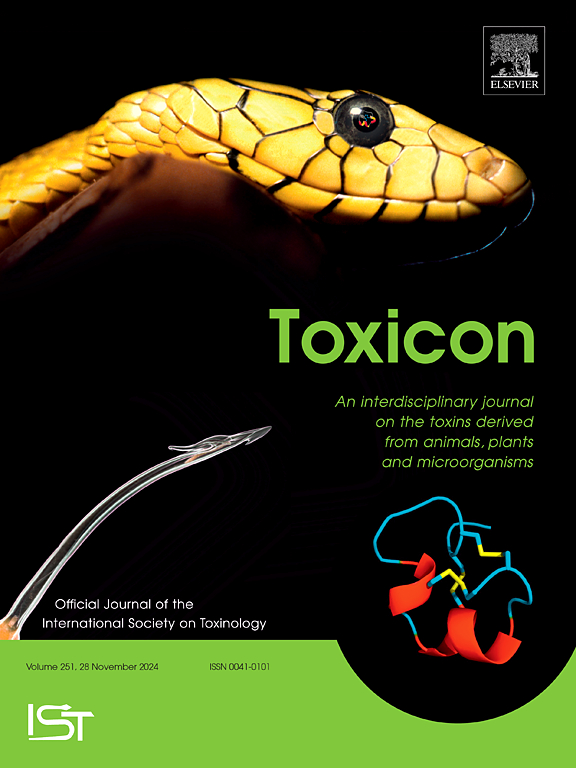天蝎毒液产量、蛋白质浓度及再生毒性的变化。
IF 2.6
4区 医学
Q2 PHARMACOLOGY & PHARMACY
引用次数: 0
摘要
蝎子毒液研究的目的是开发针对危险物种的治疗方法,并确定新药的候选药物。提取高质量的毒液,这是必不可少的,需要掌握提取和维护蝎子。正是从这个角度来看,我们已经开展了这项工作,旨在为科学地掌握蝎子的毒液产量和影响它们的因素做出贡献。进行了两个实验。首先,根据121只布氏蝎子的大小、性别、质量和产地,对其毒液的体积、产量和蛋白质浓度进行了测定。实验二,选取80只蝎子,在不同时间点(8 H、16 H、24 H、32 H、48 H、3天(D)、7 D、11 D、15 D、30 D)采集样本,测定提取后30 D内再生毒液的质量和数量,并对不同阶段小鼠采集的毒液样本进行毒性评价。电刺激提取毒液的体积与体长呈线性相关。体长与蛋白质浓度不相关。在考虑多种因素对布氏体产量的影响时,体长是最重要的影响因素,但产量也与中粒体长度和相对体重呈正相关。雄蝎子比雌蝎子产生的毒液体积更大,蛋白质浓度更高。对于毒液再生,耗尽后提取的毒液体积在几天内显着增加,到第11天达到完全恢复。相比之下,蛋白质再生和毒性比体积慢,在第15天完全恢复。这项研究将为一些研究,如治疗开发、基础研究,特别是药物开发,设计更好的毒液提取方案。本文章由计算机程序翻译,如有差异,请以英文原文为准。

Variation in venom yield, protein concentration and regeneration toxicity in the scorpion Buthus lienhardi
Scorpion venom research aims to develop treatments for dangerous species and identify candidates for new drugs. The extraction of high-quality venom, which is essential, requires mastery of the extraction and maintenance of scorpions. It is in this perspective that we have undertaken this present work which aims to contribute to scientifically mastering venom yields and the factors that influence them in scorpions.
Two experiments were conducted. In the first, the volume yield and protein concentration of venom from 121 Buthus lienhardi scorpions were examined according to their size, sex, mass and place of origin. In the second experiment, the quality and quantity of venom regenerated over 30 days after extraction were measured on 80 scorpions, with samples collected at different time points (8 H, 16 H, 24 H, 32 H, 48 H, 3 days (D), 7 D, 11 D, 15 D and 30 D). In addition, the toxicity of venom samples collected from mice at different stages was evaluated.
The volume of venom extracted by electrical stimulation was linearly related to body length. Body length and protein concentration were not correlated. When considering the multiple influences on production volume in Buthus lienhardi, the most important factor was body length, but volume was also positively associated with mesosome length and relative body mass. Male scorpions produced a greater volume of venom with a higher protein concentration than females.
For venom regeneration, the volume of venom extracted after depletion showed a significant increase over the days, reaching a complete recovery by day 11. In contrast, protein regeneration and toxicity were slower than that of volume, with a complete recovery observed by day 15.
This study should lead to the design of better venom extraction protocols for several studies such as treatment development, basic research and especially for drug development.
求助全文
通过发布文献求助,成功后即可免费获取论文全文。
去求助
来源期刊

Toxicon
医学-毒理学
CiteScore
4.80
自引率
10.70%
发文量
358
审稿时长
68 days
期刊介绍:
Toxicon has an open access mirror Toxicon: X, sharing the same aims and scope, editorial team, submission system and rigorous peer review. An introductory offer Toxicon: X - full waiver of the Open Access fee.
Toxicon''s "aims and scope" are to publish:
-articles containing the results of original research on problems related to toxins derived from animals, plants and microorganisms
-papers on novel findings related to the chemical, pharmacological, toxicological, and immunological properties of natural toxins
-molecular biological studies of toxins and other genes from poisonous and venomous organisms that advance understanding of the role or function of toxins
-clinical observations on poisoning and envenoming where a new therapeutic principle has been proposed or a decidedly superior clinical result has been obtained.
-material on the use of toxins as tools in studying biological processes and material on subjects related to venom and antivenom problems.
-articles on the translational application of toxins, for example as drugs and insecticides
-epidemiological studies on envenoming or poisoning, so long as they highlight a previously unrecognised medical problem or provide insight into the prevention or medical treatment of envenoming or poisoning. Retrospective surveys of hospital records, especially those lacking species identification, will not be considered for publication. Properly designed prospective community-based surveys are strongly encouraged.
-articles describing well-known activities of venoms, such as antibacterial, anticancer, and analgesic activities of arachnid venoms, without any attempt to define the mechanism of action or purify the active component, will not be considered for publication in Toxicon.
-review articles on problems related to toxinology.
To encourage the exchange of ideas, sections of the journal may be devoted to Short Communications, Letters to the Editor and activities of the affiliated societies.
 求助内容:
求助内容: 应助结果提醒方式:
应助结果提醒方式:


